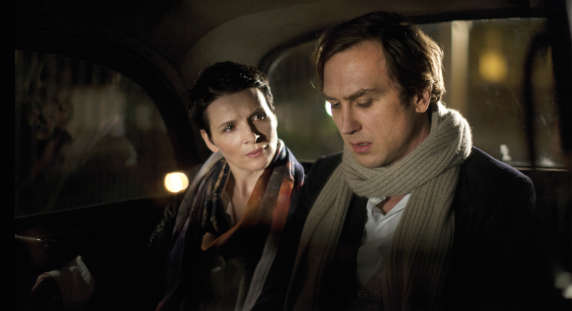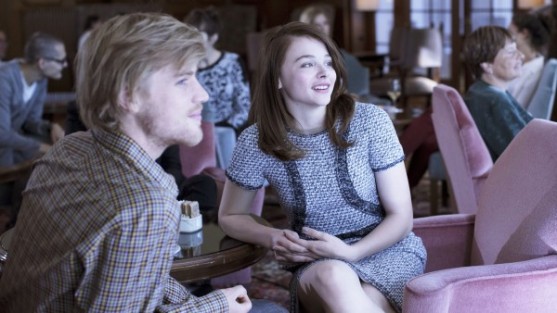A long trail of wispy clouds streaming down into the midst of the humbling peaks of the Swiss Alps; they meander, bend and glide with grace, taking the beholder with an unexpected rush of wisdom and admiration: this is the Maloja Snake, one among the many rare moments only to be witnessed in the serene altitudes of the Swiss landscapes. It is also a name shared with the play written by Wilhelm Melchior within the film Clouds of Sils Maria, which quite aptly flows and carries itself about with the same demeanour. It is a feeling of cool, subtle philosophy enhanced by the grace afforded by both the nature that surrounds Sils Maria, and the two leads Juliette Binoche and Kristen Stewart, both displaying astounding subtleties in their conversation to make far better chemistry than the latter ever did with Robert Pattinson.
The old has to be destroyed, or hide itself away to make way for the new. This is an overarching theme of Olivier Assayas’ contemplative film which cleverly leads with the classical, a lost era of morose beauty and wordier tongues which, clutching desperately onto its roots comes to terms with the cycle of replacement. Juliette Binoche plays Maria Enders, a matured actress, and Kristen Stewart her manager Valentine, both of whom we meet on their journey to the picturesque hills of Sils Maria, where they are to pay tribute to Wilhelm Mechior, the playwright who ushered Maria into the world of theatre through his play ‘Maloja Snake’. The play was about the twisted relationship that befalls an aging businesswoman and her young female employee, where Maria played Sigrid the young seductress who seemingly plays the older Helena to her strings. It is clear from the start that Maria is a character of irony, morose and pining on about desperation, while holding onto her tastes and self-conceived notions of classical art. This does not render her even a bit less endearing though, as Binoche’s rich mellow tone when uttered by a face as emotive as hers does wonders, making her the perfect personification of the unwavering and elegant classics. But this truly artsy piece is not a sermon on change, but a silent and gradual contemplation as Maria herself comes to terms with the re-enactment of the play ‘Maloja Snake’ and her imposed transition from Sigrid to Helena which she is least ready to accept. Make no mistake: this is not a thrilling movie or one of action; it is a conversation piece whose strength lies in the chemistry between the characters and the mellow serene atmosphere that is only otherwise found in the mountains where the film is set. It is particularly a niche film that, like the right wine, needs the perfect time and taste to be appreciated.
There are two particular extremes toward which films can persevere: one of character and conversation that is not something that can be thrown on during a Friday night and enjoyed, and the other of action and plot which takes the characters through events, and it is the events themselves that interest us. One of last year’s best films, Boyhood would fall under the first head while still appealing to a more universal and casual crowd. Clouds of Sils Maria on the other hand, refuses any notion of appealing to the mainstream crowd, and distances itself as far from popcorn as it possibly can. And it does so unapologetically through Maria, who outright refuses anything that the modern movie-goer would love: especially so when Maria and Valentine are watching a teen-space-action story which Maria can only scoff at. Of course, this is partly due to the impressed notion that her character is resilient and unmoved to the very end, with an air that murmurs ‘holier than thou’. This is well complemented by Stewart’s Valentine, who belonging more to this generation of superheroes and CGI in film, makes many an attempt to convince Maria that it is all not so dimensionless, while also complaining to herself about Maria’s stubbornness. She is probably the one person who can understand Maria and her hard-to-live-with ways, and it is possibly this that leads her need to go out of the way for adrenaline and for escape. Nonetheless, this unlikely duo of Stewart and Binoche make for the most natural moments that can bring both appropriate smiles and frowns on your face, depending on whether you can follow their conversation.
Kristen Stewart is incredible in this film, coming into her own with more suiting silent and real characters that can run the wavelength from frustrated restlessness to cynically understanding conversation, something no one would have thought capable of the submissive complacence of her character in the Twilight series. She has indeed surpassed the more known actresses of this generation through the slyest and slightest shades she brings out in Valentine. The chemistry between the elegant Juliette Binoche and her is impeccable, and does not suspend belief for a moment. The two fall so easily into their characters and get lost in them, and it is certainly a high benchmark that Stewart has to keep up with the experienced and masterful Binoche. In fact, I think I enjoyed the stringing conversation between the two even more than the themes evoked by the film, as meditative and effortless as they are, two who thoroughly understand not just their own, but each other’s character. Assayas also writes a clever screenplay in Sils Maria, one that can seem ever so real when it needs to, and at other times, purposefully scripted to create theatricality that is starkly different from modern cinema. The scenes are also crafted in a way that emphasizes theatre, especially with the soft fading in and out of scenes at the most unusual moments; right before expected action is to take place. This again falls within the theatrical construct of having action occur offstage or in the dark so that the light is left to dialogue, which is really its heart and what furthers it.

Yes, without Valentine this film would inevitably fall short and be lost with its head in the stars, as it is she who grounds the floating Maria whose head cannot remain but above the clouds. In a way, it is Valentine who guides Maria into accepting Helena, as the role is offered to her by Klaus the new director, as more than a puppet at the hands of Sigrid. Maria is so in love with the first character that she played that she is blinded and refuses to acknowledge the actress or the character of Helena who she considers insignificant to the play but as a faceless prey in the eye-line of Sigrid. She dismisses the actress who played Helena to her Sigrid under Wilhelm’s direction, and is proud enough to wear on her sleeve that it was her character that drove the play forward. This is all the more overwhelming and suffocating to her as she finds herself moving down the same path as that former actress, struggling to keep up and adapt to the vibrant and more rebellious Jo-Anne, who has been cast as Sigrid. In Jo-Anne, played by Chloe Grace-Moretz, she sees but refuses to accept a transposed version of herself at that age, a breath of fresh air with stood out juxtaposed with the more conventional modalities of the actress who played Helena the first time around. Through various minor and clever allusions, we learn to see things outside of Maria’s eyes, and Klaus’ version a true re-enactment, with Maria’s Helena taking her back into the shadows to make way for the new in Jo-Anne. It is, as Klaus first describes it, a more overarching story of how Sigrid becomes Helena: forgotten and dismissed, and yet it is only through such destruction and wiping away that the canvas may be splattered anew. Only one who has lived through as Sigrid, and destroyed the then old can again surface as Helena, waiting to be destroyed by the new Sigrid.
There is certainly a dearth felt when in the third act, the character of Jo-Anne is introduced, as the most anticipated enigma by Maria, and praised by Valentine turns out to fall short of expectations. While this is not particularly the fault of Grace-Moretz, the film does spend quite some time building up to the inevitable clash between Maria and Jo-Anne, which never hits in its full impact. On a deeper note, this may be owing to the audience having followed Maria’s narrative up to that point, building up the conflict in her head to be something that engulfs the both of them, only to her surprise to find that Jo-Anne is caught up in other things, just as she might have been as Sigrid. But it would be unfair to say that such a comedown does not take away from the film, flowing along a certain path to be unsettled in a hasty fashion.
The most impressive moments in Clouds of Sils Maria are the ones that involve just Binoche and Stewart, either at Wilhelm’s house or traversing the luscious landscapes surrounding the same. The conversation is invigorating and finds a right balance between Binoche’s careful elegance and Stewart’s restless energy: in fact a more apt juxtaposition than that of Maria and Jo-Anne, in the showcasing of the old classic and the energetic modern. The film captures the hills and the beautiful misty scenery of the Swiss Alps in an unfiltered and untouched manner that only such indie films can. As unconventional and distant as it is from Hollywood, it is like a fine wine that appeals only to a peculiar and more classic taste. In fact ironically, this is the sort of film that would more appeal to the classical generation represented by Maria, though it is its own destruction that is revealed by Olivier Assayas. Clouds of Sils Maria is a passive, contemplative watch that is to be enjoyed as one would the unbounded nature, an effortless character piece that moves at the slow pace that suits the phenomenon it gets its name from. And it suits it perfectly.
Rating: 8/10





Pingback: Best of 2015 in Film | DavidandStan Movies